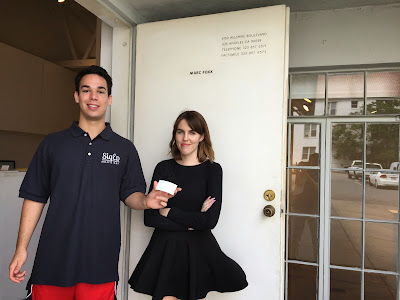 |
| Me and an Employee of the Museum at the Help Desk |
 |
| This Is The End Exhibit Sign |
 |
| Mary Reid Kelley Exhibit Sign |
I found an exhibit that at first seemed very similar to "This Is The End," but really was much more. The Mary Reid Kelley project is also a digital video, but she uses many forms of technology in the production phase of her project to help express her art form. Throughout the video, mythical creatures, many portrayed by Kelley, are shown interacting through poetry. To create this effect, Kelley used green screens to photograph the creatures with interesting backgrounds, and advanced camera skills to give the illusion that the characters are moving abnormally.
 |
| Image from the Mary Reid Kelley Project |
According to some of the helpful staff at the museum, Kelley is making a statement in her work by making the characters female based. Her project is very captivating and appears to be catered to children in an animated way while being adult like in quality and sophistication. The technical work performed to create the piece is very high quality and could be shown globally.
I would recommend that students who are very fond of out of the box art should go to the Hammer Museum. I personally did not love it because it was not as interactive as some of my other event visits, like the Griffith Observatory, but those looking for a deeper message in the artwork could enjoy the exhibits.
Works Cited
"Hammer Projects: Mary Reid Kelley." The Hammer Museum. N.p., n.d. Web. 30 May 2015. <http://hammer.ucla.edu/exhibitions/2015/hammer-projects-mary-reid-kelley/>.
Kelley, Mary Reid. Still Image taken from the Mary Reid Kelley Project. Digital image. Hammer. N.p., n.d. Web. 30 May 2015. <http://hammer.ucla.edu/exhibitions/2015/hammer-projects-mary-reid-kelley/>.






















